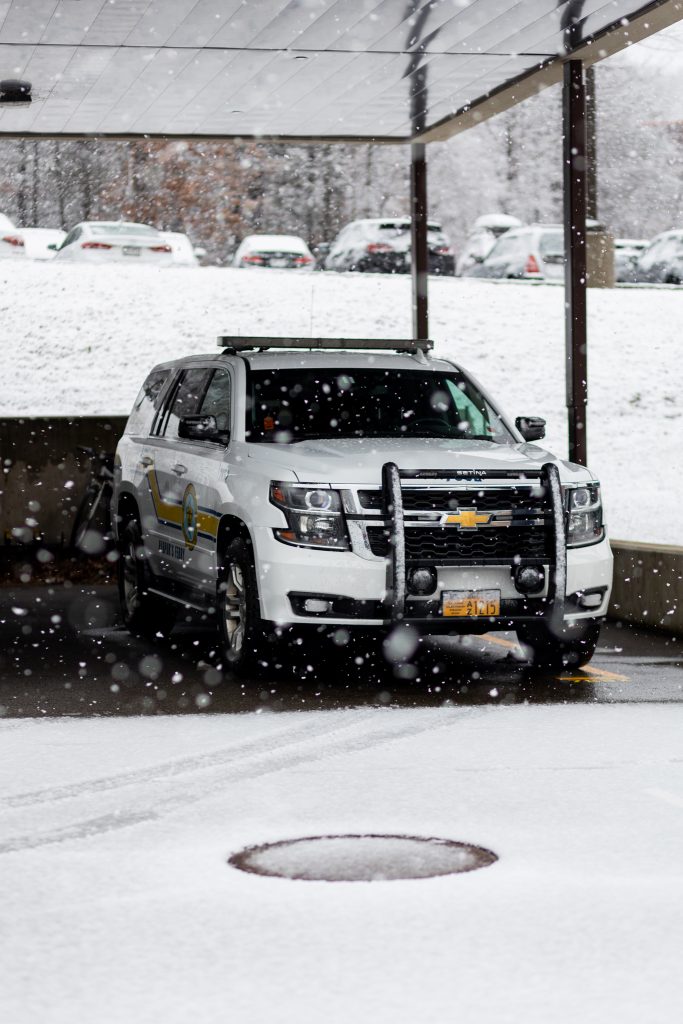Entering its 51st year, Harpur’s Ferry, Binghamton University’s student-run volunteer ambulance service, continues its work providing essential medical care to the greater campus community, while offering hands-on education for students interested in entering the medical field.
The organization, which provides free emergency medical services to students and the broader community, is the only agency to earn two recognitions as the National Collegiate EMS Foundation Agency of the Year. Patients are taken to one of three local medical facilities — Lourdes Hospital, United Health Services Wilson Medical Center or Binghamton General Hospital. Intravenous therapy and the administration of advanced medications are included in life support interventions provided by emergency medical technicians.
Harpur’s Ferry held their general interest meeting last week.
Tatum Sinopoli, the organization’s chief and executive director and a senior majoring in integrative neuroscience, described the EMTs’ day-to-day activities.
“When not responding to calls, we are training, checking medication stock or equipment inventory, planning community outreach events or doing homework,” Sinopoli said. “We are full-time college students like most of our peers at [BU] and at least 90 percent of us are undergraduates. We take the time when we can to sleep, do homework or to hang out and have fun. We all work very hard, but we support one another like a giant family. The resources and opportunities that this agency can give you are endless and almost everyone who joins ends up finding lifelong friendships.”
Between 1970 and 1972, University students ran a drug counseling program called High Hopes, housed in a small room behind the post office with a single student volunteer on duty. In 1970, the Grateful Dead performed in the West Gym, where many audience members were given LSD, leading to eight people overdosing. This event, combined with frustration at the University response was talked about frequently among members of the Tau Alpha Upsilon fraternity, as members of the fraternity were volunteering at the concert. Harpur’s Ferry’s website cites this event as the birth of the organization.
Adam Bernstein, the student founder of High Hopes, approached his friend Jon-Marc Weston, a member of TAU, after his facility began to face a large influx of students who had overdosed. The two came up with the idea of a volunteer ambulance, but administrators were unable to provide the funds to help. TAU then donated and raised enough money from the community, naming the new ambulance service Harpur’s Ferry.
At the organization’s GIM last week, student leaders described their interview process for prospective candidates. At the beginning of the process, an application must be submitted before the interview rounds begin. The first round of interviews are solo interviews. If an applicant makes it through the first round, the second round is conducted in a group. Here, the applicants will rotate through multiple short interviews before working with other applicants to complete tasks.
Acceptance into Harpur’s Ferry can be extremely competitive, depending on the semester. Sinopoli explained why many applicants are rejected.
“Harpur’s Ferry adjusts the size of each semester’s training class after reviewing our available training resources,” Sinopoli wrote in an email. “Our decisions are guided by a patient-centric ideology. We owe it to both our patients and our volunteer members to provide the [University] community with highly trained emergency medical responders. It takes a lot of dedication, experience and training to become a [field training officer] at this agency, and at any given time, we may only have five-10 of those available in a year. If you couple that with a call volume of 1500+ calls a year, we unfortunately do not have the capacity to train more than a handful of new people a semester.”
At the time, the service relied on community donations and fundraising to raise money. Eventually, the University gave the organization a budget, allowing it to grow and sustain itself. Due to support from alumni and the Student Association, Harpur’s Ferry is able to operate as a 501(c)(3) nonprofit organization.
“We want [students] to know that we are here if they need us,” Sinopoli wrote. “During an emergency, it can feel overwhelming to have to call for an ambulance, but we want students to know that we are here to help and support them through whatever they may be going through.”



